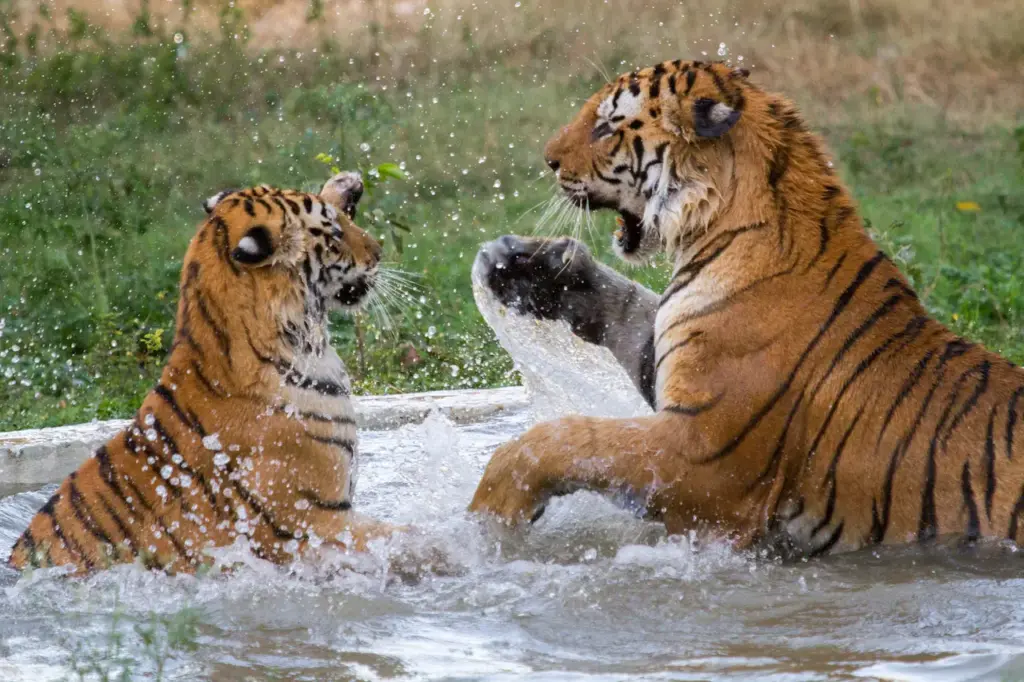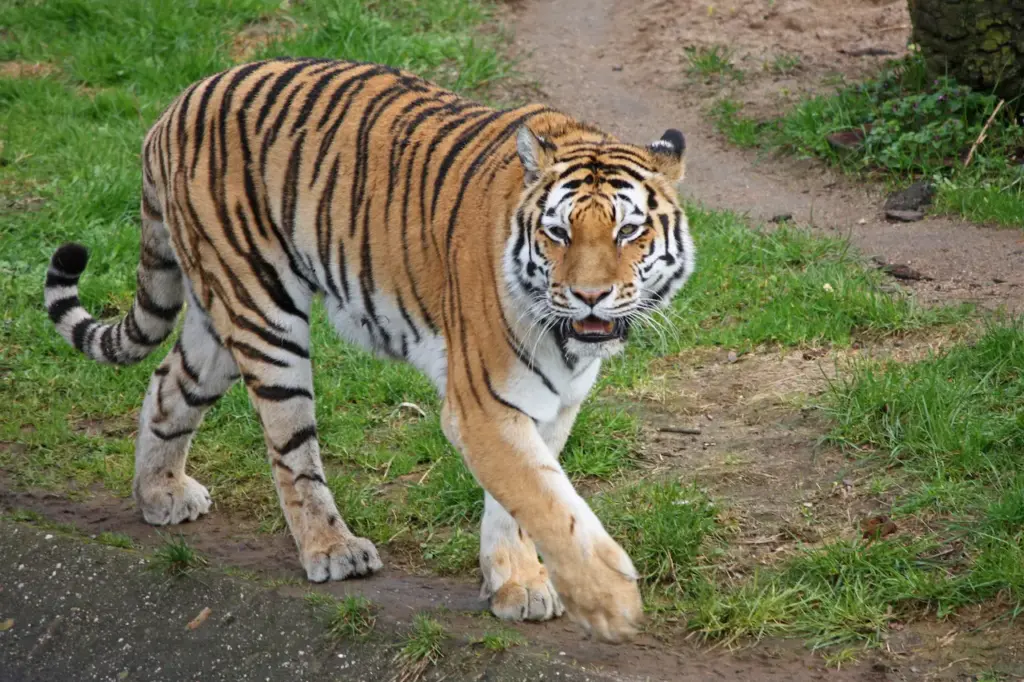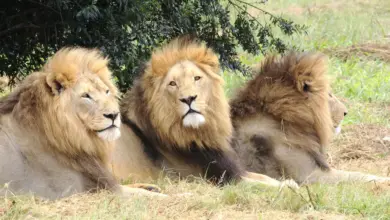What Eats Tigers?
What Eats Tigers? What Do Tigers Eat?
Tigers rank among the world’s most revered carnivores, eliciting fascination and fear in equal measure thanks to their raw power, strength, and predatory prowess.
Tigers’ intimidating muscular physiques, sharp teeth, and claws all evolved expressly to help them rule forests and jungles from India to Siberia as consummate hunters able to tackle huge prey like buffalo and bears.
Capable of taking down animals over 10 times their size, tigers might seem invincible killers. But in the natural world, survival is tenuous, even for frightening apex predators. Tigers have clawed their way to the top yet must maintain supreme vigilance to manage a bevy of threats.

While humans pose the gravest danger to modern tiger populations via habitat loss and poaching, people kill tigers with guns from a distance rather than in direct conflict.
In the wild, tigers still confront an array of fellow meat-eaters and territorial competitors that can overpower or kill tigers in especially intense battles over resources, prey, or domain assertions.
Hunger and antagonistic encounters drive dangerous face-offs between tigers and heavyweights like brown bears, wolf packs, leopards, and hyena clans. The big cats must additionally guard against stealthy nest raiders eager to snatch vulnerable cubs.
Despite the tiger’s fearsome advantages, they inevitably fall prey to these fierce ecological rivals on occasion.
Humans
Where their habitats and territories overlap, tigers also fight with humans for resources and space, making them susceptible to retaliation. And as villages and farmland increasingly expand further into wilderness reaches, negative human-tiger interactions escalate.
Desperate or wounded tigers may attack people as easy targets compared to their usual challenging wild prey. Tigers tend to drag any human victims into secluded cover to safely feed undisturbed once subdued.
Records describe sneak attacks on woodcutters, farmers, or isolated travellers throughout Asia by a tiger. Provoked by hunger or defence of cubs rather than a preference for human flesh, tigers still claim multiple lives annually across their range.
Yet tigers rarely escape such encounters unscathed. Bands of grieving local villagers soon organize well-armed hunting parties aided by elephants or dogs to methodically track and shoot the man-eating tigers, exacting revenge on the dangerous beasts.
Bears
The sloth bear and brown bear are the most likely to attack and consume tigers. On rare occasions, violent encounters between tigers and bears turn fatal for the tigers. Both bear species feature enough bulk and strength to overpower tigers under certain circumstances.
Bears directly compete with tigers for habitat and food sources. When defending carcasses, breeding rights, or cubs, bears can overwhelm tigers with their brute force and thick fur coats that help shield them.
Sloth bears exhibit especially aggressive territorial behaviours. They have sharp claws to use as weapons and canine teeth capable of biting through tiger flesh and neck bones.
These confrontational bears stand their ground when encountering the big cats instead of fleeing from danger.
Several instances of sloth bears killing tigers have been documented across India, where tigers attack bears, but the bears manage to fatally maul the tigers with bites and blows.
Meanwhile, in Russia’s Far East, Siberian tigers compete with brown bears for a game like elk and deer as well as prime fishing streams full of migrating salmon. Violent clashes sometimes erupt over contested kills or fishing spots along these rich waterways.

Wolves
As social hunters adept at running down large game across wide ranges, wolf packs also represent sporadic threats for tigers. Though wary of each other, wolves and tigers inhabit overlapping terrain.
Both species compete for the same prey animals to survive frigid northern climates. On occasion, this brings the lethal predators into direct conflict.
The balance usually tips in favour of tigers when engaging solo wolves thanks to the big cats’ ambush tactics, pound-for-pound strength advantage, and deadly bite force, which is several times more powerful.
But confrontations with multiple wolves put tigers in peril. Records exist of Siberian tiger carcasses found following clashes with packs of wolves across northeast China and Russian Siberia.
When working as a coordinated pack, wolves can harass and distract a tiger with feint attacks to enable companions to hamstring the deadly tiger or rip open flanks.
Leopards
Leopards pose threats to tigers due primarily to competition. As stealthy ambush experts sharing habitat with tigers, leopards work to avoid interactions whenever possible. But tigers greatly resent leopard intrusions into claimed domains.
Hungry tigers may even track and kill trespassing leopards on principle to eliminate the interloper. Yet leopards still manage to injure tigers during defensive counterattacks enough to eventually lead to the tiger’s death from wounds sustained in the violent exchange.
Both big cats feature camouflage, astute senses, stalking prowess, and explosive power. But tigers typically overmatch smaller leopards one on one. Inimal conflicts often arise around disputed kills that each feline covets.
Squabbling can quickly escalate to claw swipes and biting with lethal consequences. Records confirm cases of leopards mortally wounding trespassing tigers along territorial boundaries.
But the more common outcome sees the tiger eventually triumphing through intimidation or killing the leopard outright.
Hyenas
As apex scavengers can chase larger predators from carcasses, hyenas compete directly with tigers for food.
While individually no match for a tiger, hyena clans harass and steal fresh tiger kills when possible. They use pack numbers to overwhelm solitary tigers at carcasses.
Once a tiger makes a big kill like a buffalo or deer, the meat and blood scent draws prowling hyenas from miles away. Dozens of hyenas fearlessly encircle an outnumbered tiger guarding its hard-won meal.
The hyenas continually feint and bite, confusing the tiger. If the tiger lashes out against one attacker, the others dart in and nip at the legs or tail to gradually wear it down through increasing irritation and small wounds that accumulate.
Eventually, the exhausted, frustrated tiger may temporarily back down just long enough for hyenas to drag away chunks of its kill. In this way, hyenas manage to consistently deprive tigers of portions of food.
And species like the striped hyena on occasion turn the tables on tigers by violently mob attacking them for sustenance. Multiple hyenas can gnaw at the tiger carcass until little remains. Records exist of tiger body parts found inside hyena dens after such intense clashes.

Snakes
Snakes often infiltrate underground tiger dens, housing vulnerable tiger cubs while the tigress mother is away seeking food.
Sizing up tiny defenceless cubs, large snake species like Indian rock pythons and king cobras are certainly capable of ingesting smaller baby tigers if discovered.
Once inside hidden lairs, rock pythons swiftly begin coiling around and constricting tiger cubs. The pythons gradually tighten their hold around the cub each time it struggles to breathe until it suffocates within the crushing muscular coils.
King cobras offer another sinister threat. They inject tiger cubs with potent neurotoxic venom that immobilizes and soon kills the young tigers. A handful of constricted or envenomed tiger cub carcasses have emerged from vacated dens, confirming the danger snakes pose.
Conclusion
Despite unmatched strength and aggression that places Bengal tigers atop food chains, even these apex predators must watch their backs and avoid direct clashes with adversarial hunters like bears, wolf packs, leopards, hyenas, and snakes.
While rare, confirmed incidents exist, showing that tigers do occasionally fall prey. Loss of life results when tigers are forced into armed combat with nearly equal rivals or when significantly outnumbered by tenacious scavengers.
Plus, snakes add vulnerability during breeding cycles by infiltrating lairs and housing defenceless cubs. Like all successful predators, tigers aim to hunt more efficiently than competing factions, claim fruitful terrain, and protect cubs until maturity.
Avoiding costly high-risk conflicts ensures tigers minimize losses amid constant trials of survival and territorial possession.




